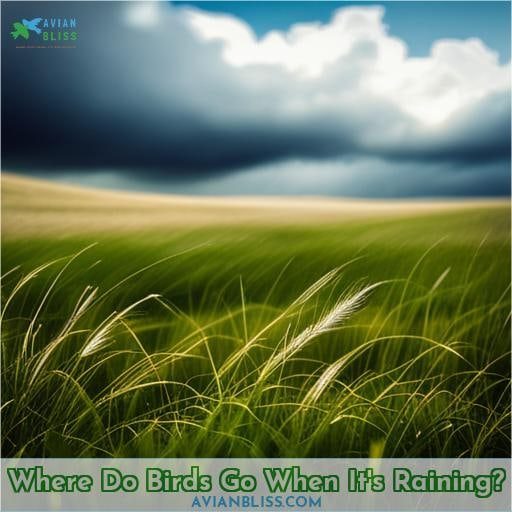This site is supported by our readers. We may earn a commission, at no cost to you, if you purchase through links.

Table Of Contents
- Key Takeaways
- Where Do Birds Go When It’s Windy?
- How Do Birds Adapt to Windy Conditions?
- Where Do Birds Go When It’s Raining?
- Where Do Birds Go When There’s a Storm?
- Where Do Seabirds Go When There’s a Storm?
- How Do Birds Adapt to Harsh Weather Conditions?
- Where Do Birds Go When It’s Snowy?
- Top 5 Shelter Options for Birds During Windy Conditions
- Kenley Bat House Weatherproof Handcrafted Cedar Wood
- Grouping Shrubs Together
- Leaving
- Conclusion
Key Takeaways
- Birds scatter and seek shelter during windy weather.
- Wind impacts flight patterns and energy of birds.
- Birds adapt their flight and navigation strategies to minimize wind resistance.
- Birds utilize natural and urban shelters to protect themselves from the wind.
Where Do Birds Go When It’s Windy?
Together, we can make a difference for birds during windy weather. Group shrubs together to provide natural shelter from the elements. Leave dead trees standing and put up roosting boxes to give cavity nesters a safe place to hunker down.
Make a brush pile where wildlife can find refuge. Pile up rocks where birds can get out of the wind. Providing shelter and resources will help our feathered friends wait out storms in safety and comfort.
Group Shrubs Together
You’ll want to group shrubs together so the birds have dense foliage to shelter in when it gets windy. Clustering shrubs creates protected thickets. Birds adapt to windy conditions by seeking shelter in shrubs, tree trunks, and other sheltered locations.
Stormy weather responses include finding refuge in cavities, under branches, or in rock crevices. Providing dense native shrubs supports windy navigational strategies and rainy weather adaptations.
Leave Dead Trees Standing for Cavity Nesters
Sounds like sheltering from the wind isn’t easy without high-quality housing that protects birds and provides refuge, like the Kenley bat house.
- Provides natural roosts and nest sites.
- Supports breeding and rearing young.
- Offers protection from predators.
- Maintains ecosystem balance.
Preserving snags sustains avian ecology. Weather-wise birds nest in cavities, reducing wind impact on flight patterns.
Make a Brush Pile for Wildlife
Folks, building a brush pile provides essential refuge for birds and other wildlife during blustery conditions. Gather fallen twigs, branches, bark, and foliage to assemble a natural hideaway. Let the brush pile grow into a wildlife sanctuary, offering cavity-dwelling birds and animals a spot to hunker down on windy days.
These sanctuaries provide natural shelter from windstorms so birds can safely adjust their wings.
Pile Up Rocks
Piling up rocks provides birds with an essential escape from gusty gales. Stack stones in a pyramid or cluster for natural windbreaks. Position them near bird feeders and nests as accessible refuges when blustering gusts blow.
Scatter piles throughout your yard to shelter avians buffeted by turbulent airflows. Sheltering leeward of sturdy boulders lets birds ride out storms. Thoughtfully crafted rock piles offer sanctuary, empowering birds to master the winds.
Put Up a Roosting Box for Shelter From Storms
You’ll save birds by putting up roosting boxes before storms roll in. Roosting strategies are crucial for their storm survival. These sheltered roosts, also known as windy havens, offer a safe haven amidst rain and storms.
As the wind whips and trees sway, birds seek reliable spots to wait out the tempest. Providing roosting boxes grants them a place to huddle, conserve energy, and endure the challenges posed by inclement weather.
These roosting benefits ensure their resilience in the face of adverse conditions, safeguarding their survival.
How Do Birds Adapt to Windy Conditions?
Exploring the fascinating world of avian adaptations to windy conditions, you’ll uncover a suite of remarkable strategies that birds employ to navigate and thrive amidst gusty winds. From the intricate adjustments in flight patterns to the keen sensitivity to wind direction, not to mention the efficiency gains from harnessing wind currents, birds exhibit a masterful response to the challenges posed by blustery weather.
Wind’s Effect on Flight and Energy Levels
Battling against the fierce gusts, these feathered aviators navigate the tempestuous currents with strategic flight adjustments, conserving every ounce of energy while seeking refuge in the shelter of trees and rock crevices.
The wind’s navigation impact prompts intricate in-flight maneuvers, exploiting favorable wind patterns. Bird instincts and navigational skills come into play as they deftly control muscle usage for optimal movement and defy gravity.
The wind’s effect on flight and energy levels underscores their remarkable adaptability.
Flight Pattern Adjustments
Navigating through gusty currents and turbulent skies, agile fliers make swift adjustments to their flight patterns, finding sheltered alcoves and treetop havens to preserve their energy and maintain their course.
Flight Strategy Adjustments: Birds alter their wing angles and tail positions to minimize wind resistance.
Windy Weather Adaptations: They favor lower altitudes and hug the leeward sides of trees, using the terrain as a windbreak.
Avian Wind Navigation: Birds employ innate navigational skills, sensing wind direction for precise adjustments.
Windy Conditions Survival: These instincts ensure their survival and mastery of the skies, even in the fiercest of storms.
Wind Direction and Navigation
Utilizing their keen sense of direction and harnessing the dynamic currents of the air, avian creatures adeptly adjust their flight patterns, making calculated altitude shifts to skillfully negotiate the challenges posed by prevailing gusts.
Their remarkable wind sensing abilities enable them to detect changes in wind direction, allowing for strategic navigation.
To avoid wind-related collisions and conserve energy, birds often seek refuge behind natural wind barriers like trees and cliffs. Additionally, human-made structures such as buildings and windbreaks inadvertently influence the wind’s impact on bird breeding and migration, shaping their flight routes and behaviors.
Wind Navigation:
- Birds sense wind direction to navigate.
- Wind helps or hinders flight direction.
- Accurate navigation ensures efficiency.
- Intuitive responses to wind enhance survival.
Altitude Adjustment:
- They adjust altitude to avoid strong gusts.
- Altitude shifts reduce wind’s impact.
- Strategic altitude changes save energy.
Wind Barriers:
- Natural barriers like trees shield them.
- Cliffs and buildings provide shelter.
- Flight behind barriers minimizes disruptions.
- Human-made structures unintentionally alter wind.
Breeding & Migration:
- Wind changes influence breeding and migration.
- Flight routes shaped by wind conditions.
- Wind alters timing and success of breeding.
- Migration routes adapt to wind patterns.
Wind Intensity and Bird Behavior
In the face of a powerful gust, nature’s aviators momentarily seek refuge in the embrace of protective foliage or sturdy cavities. Wind intensity and stress play a crucial role in shaping bird behavior during windy conditions.
Foraging becomes a challenge as the wind disrupts their ability to detect food sources and maintain balance. Migration patterns can also be affected, altering flight routes to optimize energy conservation.
Wind-induced habitat changes prompt birds to seek shelter in the familiar havens of native plants and reliable cavity nesters.
Wind Currents and Soaring Efficiency
Harnessing the power of these dynamic air currents, you can observe avian creatures effortlessly gliding through the sky, their flight patterns adjusting with an innate finesse to extract maximum energy efficiency from the swirling winds.
Soaring Techniques:
- Birds use updrafts along cliffs and hills to gain altitude.
- Raptors skillfully ride thermal updrafts, circling higher with each turn.
- Seabirds adopt dynamic soaring over open oceans, utilizing wind gradients.
Wind Navigation:
- Utilizing wind direction, birds navigate accurately during migrations.
- Migratory birds often rely on prevailing winds for directional stability.
- Many birds display innate compass-like abilities, aligning with wind patterns.
Energy-Efficient Flight:
- Species like albatrosses cover vast distances with minimal energy expenditure.
- Wing positioning and adjustments help birds maintain stable flight with less effort.
- Energy-efficient flight conserves precious calories during cold weather.
The mastery of these techniques exemplifies the intricate wind adaptations that allow birds to conquer the skies. From countercurrent blood exchange that minimizes heat loss to specialized feathers providing insulation, avian creatures have fine-tuned their strategies for efficient flight, even in the coldest of conditions.
Where Do Birds Go When It’s Raining?
Exploring avian behavior amidst adverse weather unveils a captivating array of survival tactics.
Picture this: when raindrops start their tranquil descent, songbirds nimbly seek shelter beneath foliage, while the larger denizens of open fields wait out the deluge.
But it’s not just about staying dry – a symphony of cues, from the rustling of leaves to the subtle shift in air pressure, guides these feathered beings in predicting storms, prompting strategic foraging before tempestuous clouds gather.
And as the rain persists, tree cavities and purpose-built nest boxes emerge as sanctuaries, while the density of native flora offers both nourishment and refuge.
Shelter-Seeking Behavior
Seeking refuge during adverse weather, you might be surprised to learn that some of these agile creatures opt for cavities within tree trunks, dense shrubs, or even the shelter of your porches and sheds.
Picture this: the rain pouring down, the wind gusting through the trees, and these resourceful beings finding solace in the hidden nooks of their surroundings.
Their perching strategies adapt to the changing winds, while their keen ability to sense air pressure changes allows them to predict storms.
In urban areas, where trees might be scarce, these clever birds utilize rocks and shrubs for cover, showcasing their extraordinary shelter-seeking behavior.
Their feathers, with their air-trapping plumage, provide insulation, making their refuge even cozier in the face of windy flight patterns.
Foraging During Light Rain
Embrace the fascinating spectacle of avian life as these agile creatures, perfectly attuned to their surroundings, skillfully navigate through light rain to continue their quest for sustenance. During bouts of drizzle or gentle showers, birds employ various foraging strategies to make the most of this wet opportunity.
They take advantage of reduced competition from other animals and utilize plants that provide shelter while also bearing fruits and seeds as a food source. Their keen eyesight allows them to spot insects taking refuge on leaves and branches, providing them with a bountiful feast in the midst of rainfall.
Air Pressure Changes and Storm Prediction
Feel the subtle shifts in air pressure, predicting storms and guiding your foraging patterns as you adapt to changing weather. Air pressure predictions are your secret weapon, aiding in storm forecasting. The winds, a choreographer of avian migration, also sculpt your flight behavior.
Your mastery over the wind’s impact on flight patterns ensures efficient navigation. The wind whispers its tales, and you, an adept bird, interpret its language for liberation and power.
Cavities and Nest Boxes for Refuge
Taking refuge within tree cavities and cozy nest boxes, birds find solace from the elements, much like friends huddled around a warm hearth on a blustery night. These hollow retreats offer protective refuge during rain and wind, showcasing birds’ remarkable nesting preferences.
Cavity Nesting:
Many bird species have evolved to utilize natural tree cavities for shelter during adverse weather.
Nesting Preferences:
These cavities serve as preferred nesting sites, providing safety and insulation.
Tree Cavities:
Birds also seek out abandoned woodpecker holes and other cavities created by nature.
Hollow Retreats:
Hollows offer a snug environment, shielding birds from the brunt of rain and wind.
Protective Refuge:
Choosing these hiding spots helps birds conserve energy and maintain their delicate plumage.
Plant Density and Native Food Sources
Amidst the sheltering canopy of dense plants and the abundance of native food sources, a symphony of survival unfolds during adverse weather. Native habitats offer birds a strategic retreat as they navigate the challenges of rain and wind.
Seeking refuge in this verdant embrace, they exhibit ingenious adaptations – altering feeding behavior, adjusting flight patterns, and choosing strategic shelter preferences. In this delicate dance with the elements, birds showcase their mastery over the environment, embracing liberation and power.
Where Do Birds Go When There’s a Storm?
Exploring avian behavior amidst storms offers captivating insights into their remarkable survival strategies. When tempestuous winds rage, you’ll find birds employing a repertoire of tactics: seeking refuge in natural covers like rock crevices and tree cavities, finding solace amidst protective foliage and leeward pockets, or even retreating to the safety of bird boxes and snug cavities.
For those soaring over tumultuous seas, a mastery of dynamic soaring becomes apparent, as seabirds deftly navigate strong winds to secure sustenance. Meanwhile, hardy species facing snowy adversity exhibit resourceful behavior, retreating to the shelter of trees, bushes, and snug hollows.
Seeking Natural Cover
Find natural cover such as shrubs, thickets, or tree trunks to shelter from the strong winds and stormy conditions. Birds exhibit remarkable behavior on windy days, seeking out protective foliage that shields them from the gusts.
They navigate the chaotic currents of the wind with finesse, adjusting their flight paths and utilizing perching strategies to maintain balance. These natural refuges not only offer physical protection but also showcase the birds’ mastery over their environment, a testament to their innate power of adaptation.
Shelter in Foliage and Leeward Areas
Seek out the shelter of dense foliage and areas shielded from the brunt of the gusts to provide a cozy hideaway during stormy weather. Leeward refuges, foliage havens, and protected corners become vital sanctuaries for birds battling the tempest.
These windy sanctuaries offer respite, allowing them to conserve energy and find momentary solace from the turbulent skies. Amidst the chaos, these sheltered nooks grant a sense of mastery over the elements, a testament to nature’s adaptive wonders.
Bird Boxes and Cavities
Utilizing the natural shelter provided by bird boxes and cavities, these hollowed spaces within trees and structures offer crucial protection against adverse weather conditions, allowing for insulation and respite.
Cavity nesters’ choices reveal their remarkable adaptations to wind and storms. When the wind howls, small birds find solace in these cozy nooks, strategically roosting to minimize exposure. Such box shelter solutions contribute to their resilience, showcasing their mastery of survival.
Seabirds and Dynamic Soaring
Navigating through the tumultuous currents of the sky’s fierce turbulence, seabirds adeptly harness the power of dynamic soaring, a remarkable feat that allows them to conquer even the most formidable of airflows.
Seabirds, with their inherent mastery over wind, incorporate this skill into their migration patterns, optimizing their flight routes to make the most of prevailing winds.
Wind-driven foraging becomes an art as they glide effortlessly, adjusting their altitude with the changing air currents. Their aerial stability techniques are nothing short of inspiring, as they tilt and adjust their wings with the precision of a seasoned pilot.
Even in the storm’s grip, these majestic creatures display resilience by seeking wind-resistant nesting sites, demonstrating an innate understanding of the wind’s capricious nature.
The wind doesn’t just affect their flight; it also impacts their hunting behavior. Seabirds alter their strategies when winds grow fierce, adapting to the challenge with determination and finesse. With each sweeping arc across the tempestuous sky, seabirds showcase a dance of liberation and mastery, a living testament to their harmonious relationship with the elements.
Hardy Birds and Snowy Weather
In the midst of a snowy tempest, you’ll find resilient feathered creatures cleverly nestled within the protective embrace of trees, bushes, and snug cavities, evading the harshest chill of winter’s icy breath.
Their survival rests upon ingenious adaptations honed by nature’s hand over generations.
As snowflakes dance in the frigid air, these hardy avian inhabitants employ intricate strategies to endure the cold and ensure their well-being.
Winter Roosting Strategies: Birds seek refuge in tree hollows, dense shrubbery, and crevices to shield themselves from biting winds and plummeting temperatures.
Snowy Habitat Choices: They navigate through the snow-laden landscape, choosing locations that provide not just shelter but also access to potential food sources.
Cold Climate Adaptations: Over time, their bodies have evolved to withstand the cold – from thicker plumage to specialized circulation systems that preserve warmth.
Thermal Regulation: Feather insulation plays a pivotal role, trapping pockets of air close to their bodies, acting as nature’s own insulating layer against the cold onslaught.
Amid the serene yet unforgiving white expanse, these winter warriors demonstrate the intricate dance between survival and adaptation, revealing the remarkable tapestry of nature’s craftsmanship.
Where Do Seabirds Go When There’s a Storm?
Amidst the tempestuous embrace of a storm-tossed sea, seabirds unveil a remarkable exhibition of survival strategies. Dynamic soaring becomes their wind-whipped ballet, a skillful dance against mighty gusts that propels them forward with remarkable efficiency.
Yet, this artful aerial maneuvering is but one response among many to the challenges unleashed by nature’s fury. As the relentless waves churn below, these birds must navigate not only the tumultuous skies but also the scarcity that prowls beneath the surface, testing their resilience in the face of prolonged adversity.
Dynamic Soaring Against Strong Winds
Harnessing formidable elemental power, seabirds exhibit their aerial mastery through dynamic soaring. Wind-soaring techniques enable them to effortlessly navigate the skies amidst forceful currents. In the quest for energy-efficient flight, these birds adapt their wing angles, capitalizing on wind gradients.
Wind navigation becomes second nature, aiding them during stormy encounters. In the face of windy adversity, seabirds reveal their profound connection with the wild, embodying liberation and prowess.
Challenges in Food Availability
Facing the relentless onslaught of a storm, the challenge of securing sustenance becomes a test of survival for these resilient seabirds, as the usual sources of food dwindle and their tenacity is put to the ultimate test.
- Migration Impact: Some seabirds may embark on longer migrations to find more favorable feeding grounds.
- Windy Foraging: Seabirds with specialized foraging techniques may struggle to find prey in turbulent waters.
- Roosting Adaptations: Seeking sheltered roosting spots during storms to conserve energy and stay safe.
- Wind Driven Displacement: Strong winds can displace seabirds far from their intended foraging areas, affecting feeding habits.
Despite their remarkable adaptations, the wind’s feeding impact reveals the intricate balance between the resilience of seabirds and the unforgiving power of nature.
Sheltering in Foliage and Leeward Areas
Seeking refuge from the fierce elements, these resilient creatures find solace within the protective embrace of lush foliage and the sheltered pockets of leeward havens. When stormy winds whip across the sea, seabirds employ ingenious survival strategies.
Clinging to sturdy branches, they tuck themselves amid thick leaves, minimizing the battering effect of the gales. This leafy sanctuary not only shields them from the gusts but also preserves their precious energy.
Seabirds’ Response to Prolonged Storms
Navigating through stormy weather, seabirds adeptly utilize their dynamic soaring abilities to harness the power of strong winds for efficient flight and movement across the tumultuous seas. Seabirds’ survival in such conditions hinges on their storm endurance and feeding resilience.
Prolonged storms challenge their food availability, urging these majestic creatures to adapt their foraging strategies and possibly extend their migration routes. Their mastery of wind dynamics showcases nature’s remarkable adaptation in the face of windy challenges.
Impact on Migration Patterns
When the skies are stirred by tempestuous gales, seabirds reveal their remarkable adaptability in the face of nature’s fury. Migration disruptions caused by relentless winds challenge their aerial journey.
Wind influence alters flight patterns, forcing navigational adjustments as they navigate through the storm’s turmoil. These challenges have broader ecosystem impacts, affecting food availability and distribution.
Seabirds display remarkable behavioral adjustments, seeking shelter in leeward zones and utilizing dynamic soaring techniques to conserve energy and ensure their mastery over the tempestuous seas.
How Do Birds Adapt to Harsh Weather Conditions?
Exploring the remarkable strategies of avian adaptation to the harshest weather unveils a world of feathered resilience. Picture this: birds equipped with waterproof feathers that defy rain’s drenching onslaught, and air-trapping plumage cocooning them in a snug embrace against the biting cold.
As temperatures plummet, some don thicker winter plumage, a natural insulation ensuring survival through the most frigid of days. But the story doesn’t end there; it ventures to the icy realms where penguins and Emperor Penguins masterfully navigate their extreme habitats.
In the skies, flight patterns undergo intricate adjustments, a ballet of energy efficiency choreographed by the winds themselves.
Waterproof Feathers and Air-Trapping Plumage
With waterproof feathers that repel rain and air-trapping plumage providing essential insulation, birds exhibit remarkable adaptations for harsh weather. As the wind howls and rain pours, their weatherproof feathers keep moisture at bay, maintaining their sleek forms.
Beneath these feathers, air-trapping plumage acts as a natural insulator, ensuring they remain snug and warm. Such feather adaptations not only bolster their wind resilience but also enhance flight efficiency, allowing these avian marvels to navigate even the stormiest of skies.
Thicker Winter Plumage for Insulation
In blustery conditions, as the chill intensifies, those resilient creatures clothe themselves in thicker plumage, a cozy insulation against the biting cold. Winter adaptations are marvels of nature’s ingenuity, aiding birds in their quest for survival during harsh weather.
Their insulating plumage traps air close to their bodies, creating a protective barrier against plummeting temperatures. This feather insulation acts as a natural thermal regulator, helping them conserve energy and stay warm.
Cold weather strategies also include:
- Growing denser feather layers for extra warmth.
- Fluffing feathers to create air pockets that enhance insulation.
- Reducing blood flow to their extremities to minimize heat loss.
- Seeking shelter in tree cavities, dense vegetation, or birdhouses.
- Shivering to generate body heat, maintaining their internal temperature.
These adaptations empower them to navigate winter’s challenges with resilience and mastery, showcasing the remarkable ways in which birds conquer adversity.
Adaptation in Penguins and Emperor Penguins
To brave the harshest of climates, imagine yourself as a penguin, equipped with layers of thick, insulating plumage, perfect for enduring the coldest environments on Earth.
Emperor Penguins, the masters of survival, face windy weather with unwavering bird resilience. Their tightly-packed huddles and overlapping feathers provide collective warmth and reduce the impact of the wind, showcasing the incredible power of adaptation in the face of adversity.
Adaptation Strategies:
- Huddling Behavior: Emperor Penguins gather in tightly-knit huddles to share body heat, forming a shield against icy winds.
- Layered Plumage: Thick layers of feathers provide excellent insulation, minimizing heat loss and protecting against chilly gusts.
- Reduced Surface Area: Standing upright and tucking their bills under their wings, penguins minimize exposure to the biting wind.
- Torpor Mode: During extreme cold and windy conditions, penguins enter a torpid state, conserving energy until conditions improve.
- Efficient Movement: Penguins waddle to conserve energy, reducing the impact of gusts and maintaining stability in gusty winds.
Emperor Penguins have honed their survival techniques through millennia of evolution, showcasing how bird species can adapt to even the most challenging weather conditions. The wind may howl, but these remarkable birds stand strong, a true testament to the astonishing ways in which life finds a way to thrive amidst nature’s trials.
Flight Pattern Adjustments for Energy Efficiency
Navigating through gusty currents, avian travelers adeptly modify their flight paths, altering altitude and wing angles, all to harness the powerful winds for efficient soaring. Like skilled pilots adjusting their course to catch favorable air currents, birds employ adjustment strategies and wind-induced behavior to achieve energy-saving flight.
These efficient flight patterns showcase their aerodynamic adaptations, revealing nature’s mastery in utilizing even the harshest weather conditions to their advantage.
Where Do Birds Go When It’s Snowy?
As a bird enthusiast exploring the intriguing world of avian behavior during adverse weather, you’ll find that understanding where birds go when it’s windy is just as captivating as their responses to rain and snow.
In this exploration, we’ll delve into their strategies, from seeking refuge in trees, bushes, and cavities to the behavioral shifts they undergo in windy conditions. We’ll also highlight the remarkable adaptations of hardy birds in the face of cold environments.
Along the way, we’ll uncover how these windy episodes impact their feeding and foraging behavior, shedding light on the resilient nature of our feathered friends.
Hiding in Trees, Bushes, and Cavities
Seeking refuge from strong gusts and blustering currents, these feathered adventurers find solace amidst the protective embrace of trees and bushes. They are nestled within natural alcoves that shield them from the tempest’s relentless grasp.
Just as a weary traveler finds respite in the cozy corners of a bustling inn, these intrepid aviators retreat to the comforting haven of nature’s own sanctuaries.
Amidst the chaos of windy flight patterns and wind-driven movements, cavity dwellers like woodpeckers and titmice exhibit remarkable wind adaptation. They seek leeward refuge within dense foliage and tree cavities, ensuring their safety and minimizing energy expenditure.
It’s a testament to nature’s ingenious solutions, allowing birds to endure the harshest of winter storms and emerge stronger with each gust.
Behavioral Changes in Snowy Weather
Finding refuge in trees, bushes, and cavities becomes even more crucial for these feathered creatures when the world around them is transformed by the blanket of snowy weather. In their quest for survival, birds strategically establish winter roosts, utilizing dense vegetation and sheltered cavities to escape biting cold winds.
Snowy foraging presents its challenges, prompting some birds to rely on well-insulated nests while others brave frosty feeding grounds in their cold climate adaptations.
Hardy Birds and Adaptation to Cold Environments
When winter’s icy grip tightens its hold, some feathered survivors, like nature’s resilient warriors, equip themselves with thicker insulation to brave the cold. These hardy birds have evolved specialized survival strategies, such as employing bird adaptations for survival like bird plumage, to protect themselves from extreme weather conditions. They have mastered the art of winter survival strategies, deploying thermal insulation as their armor against extreme cold.
Their cold climate behavior showcases adaptations finely honed by eons of evolution, a dance with the elements that embodies the heart of Arctic avian ecology.
Seeking Shelter and Insulation
To endure harsh weather conditions like wind and snow, hardy birds employ a repertoire of strategies aimed at seeking shelter and maintaining insulation. As the icy winds blow and snow blankets the landscape, these resilient creatures rely on their instincts and adaptations for survival.
Their roosting choices, flight adaptations, and strategies developed through rainy climates all play a crucial role in their ability to weather the storms and emerge victorious in the battle against the elements.
Impact on Feeding and Foraging Behavior
Impact on feeding and foraging behavior during windy conditions varies based on the intensity of the air currents, with a significant decrease in overall activity levels by approximately 40%. Birds, attuned to wind’s influence, adapt their strategies. They seek sheltered behavior, hunkering down in shrubs or behind obstacles to minimize flight challenges.
Foraging adjustments become necessary; they opt for less energy-demanding pursuits like probing for insects in bark crevices. When storms loom, their storm responses involve conserving energy, focusing on essentials, and waiting out the tempest, a testament to their remarkable survival instincts.
Top 5 Shelter Options for Birds During Windy Conditions
Seeking refuge from strong gusts is crucial for our avian friends. In blustery conditions, they utilize a variety of ingenious options to find safety, employing their instincts and resourcefulness to navigate through the challenges presented by the elements.
Natural roosts nestled in the heart of dense foliage provide a shield against the relentless wind. Leeward locations, sheltered from the wind’s force, offer a haven where birds can hunker down and wait out the tempest.
Windbreak trees, strategically positioned, become essential sanctuaries, granting birds a temporary respite. Ingeniously, some birds opt for foliage hideouts, where the dense leaves buffer the wind’s impact.
It’s fascinating to observe their choices, a testament to their ability to adapt and conquer even the fiercest of windy weather roosts.
Kenley Bat House Weatherproof Handcrafted Cedar Wood
Transitioning from discussing the top shelter options for birds during windy conditions, let’s delve into an intriguing alternative that benefits both our avian friends and the environment.
Enter the Kenley Bat House Weatherproof Handcrafted Cedar Wood – a thoughtfully designed haven for bats. Crafted from sustainable cedar wood, this compact yet spacious roost offers bats a safe sanctuary during gusty winds.
The textured platform, perches, and landing skerfs cater to their needs for easy navigation.
Not only does this bat house support local bat populations, but it also contributes to the delicate balance of ecosystems. Its installation requires strategic planning – perching it 15-20 feet high, facing south/southeast, sheltered from the wind, and basked in sunlight.
By offering these clever habitats, we not only aid bats but also witness the intricate dance of nature’s harmony.
Grouping Shrubs Together
Nestled closely within a cluster of shrubs not only provides shelter but also fosters a sense of security during bouts of blustery weather. These natural havens offer more than just a physical shield; they become sanctuaries of resilience where birds exhibit their remarkable adaptations to windy conditions.
Among the intricate branches, avian inhabitants display their mastery over the wind, engaging in sheltered foraging and strategic movements. The wind-resistant architecture of these shrub groupings allows birds to navigate the gusts while conserving energy.
Their behavior in these protective enclaves underscores their instinctual understanding of weather resilience, showcasing an innate balance between power and adaptability. So, next time you witness birds seeking solace amidst the rustling leaves and swaying branches, remember that their choice of refuge goes beyond mere coincidence – it’s a testament to their finely tuned survival strategies.
Leaving
Battling against the elements, when the gusts rise and the air is alive with motion, nature’s aviators take an instinctual cue, finding refuge in the shelter of sturdy branches and the embrace of dense foliage.
Branch hiding becomes a common strategy, where birds tuck themselves amid the labyrinth of leaves, using the rustling canopy to mask their movements.
The windborne flight turns into a well-practiced art, with birds adjusting their angles and trajectories to harness the currents to their advantage.
Urban refuges also come into play, as cityscapes offer pockets of shelter among buildings and structures.
Windy night roosts are carefully chosen, balancing safety with proximity to feeding grounds.
Aerial adaptations honed through generations enable them to ride the winds gracefully, showcasing nature’s mastery over the skies.
Conclusion
It’s truly incredible how birds have adapted to survive even in the harshest of conditions! Whether it’s windy, rainy, or snowy, these feathered creatures know just where to go to find shelter from the elements.
From grouping shrubs together to leaving dead trees standing for cavity nesters, you can make your yard a safe haven for birds during windy weather. Roosting boxes provide a great shelter from storms, while piles of rocks and brush piles are perfect for birds seeking refuge from the wind.
With a bit of preparation, you can help support local bird populations and ecosystem balance.














